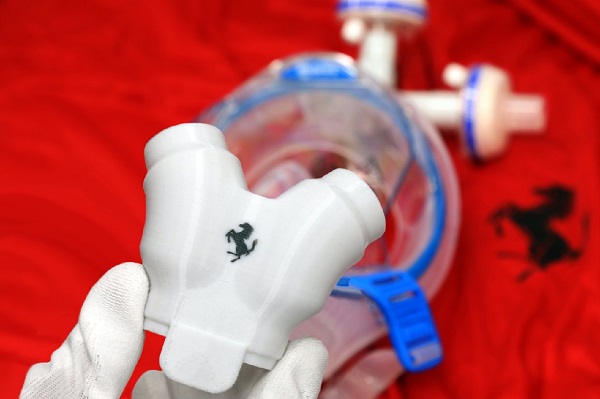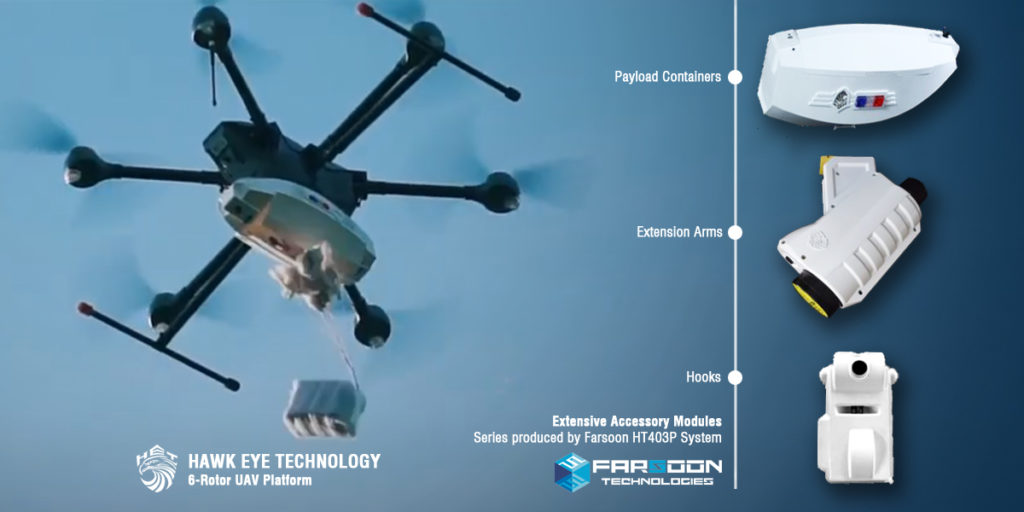Companies, organizations and individuals continue to attempt to lend support to the COVID-19 pandemic supply effort. We will be providing regular updates about these initiatives where necessary in an attempt to ensure that the 3D printing community is aware of what is being done, what can be done and what shouldn’t be done to provide coronavirus aid.
A large number of businesses continue to support medical supply efforts. This includes Ferrari, who is 3D printing respirator valves and fittings for protective masks as part of a collaborative effort with Siare Engineering, Italy’s only maker of pulmonary ventilators. In California, XYZprinting Inc. and students from Beckman High School in Irvine are using a print farm of over 20 da Vinci 1.0 Pro 3D printers to make over 500 face shields for Hoag Hospital in Newport Beach. HP has confirmed that its 3D printed nasopharyngeal swabs were clinically validated by Beth Israel Deaconess Medical Center (BIDMC) and is working to use its global partner and customer network to prepare for mass production of swabs.
The E.U.’s private-public AMable project is offering aid and public funding for COVID-19 projects. Having already supported the development of small-to-medium-sized enterprises involved in industrial metal and plastic 3D printing, the AMable network is requesting ideas for various coronavirus-related medical supplies and equipment, which will be followed by the additive production of viable items.
Because there already exist a wide variety of existing solutions for the medical supply effort, the AMable network—led by Fraunhofer Institute for Laser Technology (ILT)—is aiming to find ways to use AM to get around bottlenecks, produce medical supplies faster and more effectively. Ulrich Thombansen, project coordinator and scientist at Fraunhofer ILT, explained:
“There are already many ideas from SMEs for solving this pressing problem with the aid of additive processes. We are investigating in which cases 3D printing can be used to produce components faster and more reliably than conventional processes and how current needs can be met as quickly as possible with new solutions.”
What Thombansen sees so far is a demand for small extruder 3D printers on location to produce goods locally and on-demand. The AM network is looking for ideas that can take advantage of these low-cost systems by placing a call through social media and traditional media channels. AMable will support these ideas with public funding (project funding totals €350,000) and suitable partners and experts. Submissions should consist of a freely accessible design file with documentation for items that can be reliably 3D printed at the push of a button.
As an example of a successful idea, AMable points to a project at the University of Marburg, in which CPAP devices for treating sleep apnea have been modified for use with COVID-19 patients, and projects in which diving masks have been converted into respiratory aids. We have discussed a variety of these projects and their important distinctions in a previous post here. Those wishing to submit ideas can visit this page at the AMable website.
Similarly, the European transportation-focused AM network Mobility goes Additive (MGA) has issued a call for personal protective equipment for non-profit Johanniter-Unfall-Hilfe e.V. in Berlin. MGA requested help with producing or procuring 5,000 face shields and other items for the group’s over 23,000 full-time staff and roughly 40,000 volunteers. The group is operating in nearly 300 official bodies throughout Germany and is a key part of the country’s healthcare system. Those wishing to support the effort can visit medicalgoesadditive.org.
Farsoon Technology, China’s leader in plastic and metal laser powder bed fusion (PBF) systems, has moved beyond 3D-printed safety goggles in the COVID effort and is now working on unmanned aerial vehicles (UAV). Hawk Eye Electronic Technology Co., Ltd, a Chinese manufacturer of customized civil emergency UAV systems, has adopted Farsoon’s PBF technology to produce not only prototypes during the development of new drones, but also accessories used to deliver medical supplies.
Hawk Eye’s six-rotor UAVs are designed to carry medical supplies at high speeds, operating for up to an hour and capable of carrying up to 13 kg of weight. To deliver a variety of medical supplies in response to the COVID-19 outbreak in China, the drones have relied on specialized accessory mounts, such as extension arms, hooks and payload containers, all of which have been made on Farsoon 403P plastic laser sintering systems.
Hawk Eye has said that new UAV accessories typically take about nine months to perform three design iterations, with the design of new tools and molds adding over $5,000 to the cost of production. For this reason, the company adopted Farsoon’s HT403P laser sintering system in 2017, which resulted in a design-prototype-verification cycle of only 3 months. The company has since used AM to make over 100 UAV modules and add-ons and develop three completely new UAVs.
According to Hawk Eye’s head of manufacturing: “Most of the UAV’s housings is produced on Farsoon 403 systems, and functional parts such as connectors, supports, adapters and electric fuse boxes. Additive technology also helps us to establish our digital inventory to reduce the cost of spare parts, and reduce the lead time for new production inquiry. These benefits become powerful production tools especially during the time of Covid-19 pandemic where supply chains were disrupted, we were able to produce extra orders of accessory mounts for emergency UAVs.”
China is not the only one using drones to deliver supplies in response to the COVID-19 pandemic, though its use of 3D printing to produce accessories may be unique. Among the other locales UAVs are being deployed are North Carolina, Ghana, and Spain. In China, India, the Philippines and South Korea drones are being used to spray chemical disinfectant. While these devices may have the ability to drop off goods to remote locations without becoming contaminated, the idea of drones delivering medical supplies is one that naturally leads to questions about their use for surveillance. (Dousing cities in chemicals raises its own separate set of issues.)
U.S. reporting on China has its own built-in issues, due to the perceived economic and potentially military competition between the two superpowers. It is thus difficult to effectively decipher facts from stories such as the Wall Street Journal video below, which suggests that drones are being used by Chinese authorities to enforce quarantine.
However, surveillance concerns extend to residents of nearly every state. In the U.S. and Canada, Draganfly drones are used by law enforcement. The same manufacturer is now looking to add thermal cameras to detect elevated body temperatures as a symptom of fevers from COVID-19, which will be used in Australia’s coronavirus response. It goes without saying that we’ve already seen troubling use of military drones by the U.S., which deploys its military UAVs to not only surveil but select military targets.
Though the enforcement of quarantine is likely necessary in order to manage the SARS-CoV-2 outbreak, it is not unreasonable to fear the pandemic being used as a pretext for greater authoritarian control. In the U.S., the Center for American Progress has proposed the use of a phone app for tracking people’s movements to notify them if they interact with someone with COVID-19, similar to technology already being jointly developed by Google and Apple. The Rockefeller Foundation, founded by one of the most nefarious monopolies in history, has suggested integrating the population’s biometric data into national and state surveillance systems.
We have not yet seen these proposals acted upon, but, in Chile, a less tech-savvy version is taking shape via immunity cards for people testing positively for SARS-CoV-2 antibodies. These cards allow residents to travel freely, despite the fact that antibody testing is still proving to be problematic.
For anyone who hasn’t read or watched science fiction over the past 70 or 80 years, these technological solutions may not seem all that disconcerting. However, given the fact that the events of 9/11 were used to rush through the Patriot Act, a set of some of the most wide-reaching surveillance laws in the U.S., it may pay to be wary of some of the corporate and government efforts being instituted in response to the COVID-19 pandemic. Therefore, rather than quickly pass along a story about exciting UAVs and 3D printing can be, it is worth including some of the implications of normalizing this technology in everyday life.
As the pandemic continues to grip the world, we will continue to provide regular updates about what the 3D printing community is doing in response. As always, it is important to keep safety in mind, remain critical about the potential marketing and financial interests behind seemingly good humanitarian efforts from businesses, and to do no harm.
Subscribe to Our Email Newsletter
Stay up-to-date on all the latest news from the 3D printing industry and receive information and offers from third party vendors.
You May Also Like
Profiling a Construction 3D Printing Pioneer: US Army Corps of Engineers’ Megan Kreiger
The world of construction 3D printing is still so new that the true experts can probably be counted on two hands. Among them is Megan Kreiger, Portfolio Manager of Additive...
US Army Corps of Engineers Taps Lincoln Electric & Eaton for Largest 3D Printed US Civil Works Part
The Soo Locks sit on the US-Canadian border, enabling maritime travel between Lake Superior and Lake Huron, from which ships can reach the rest of the Great Lakes. Crafts carrying...
Construction 3D Printing CEO Reflects on Being Female in Construction
Natalie Wadley, CEO of ChangeMaker3D, could hear the words of her daughter sitting next to her resounding in her head. “Mum, MUM, you’ve won!” Wadley had just won the prestigious...
1Print to Commercialize 3D Printed Coastal Resilience Solutions
1Print, a company that specializes in deploying additive construction (AC) for infrastructure projects, has entered an agreement with the University of Miami (UM) to accelerate commercialization of the SEAHIVE shoreline...

































